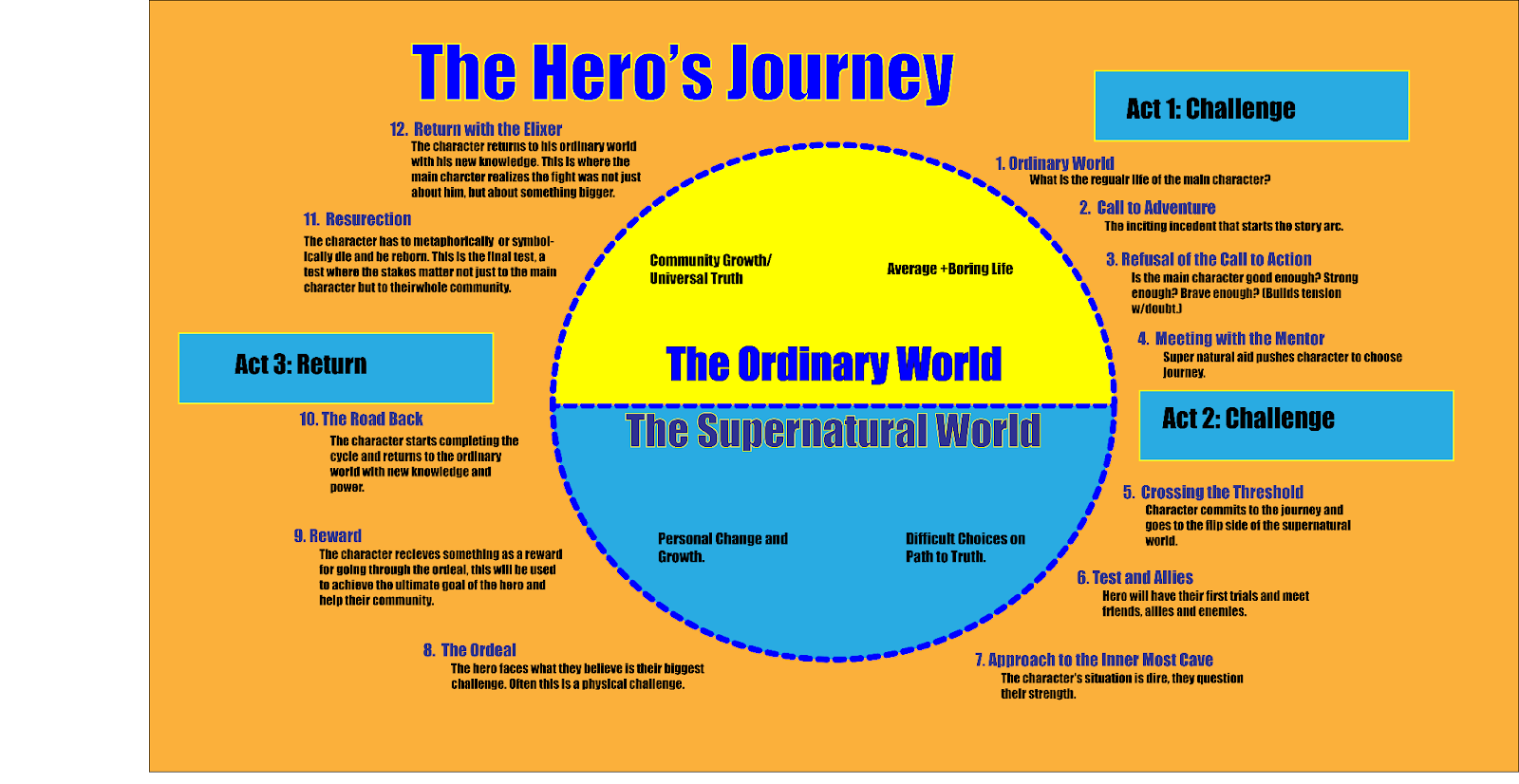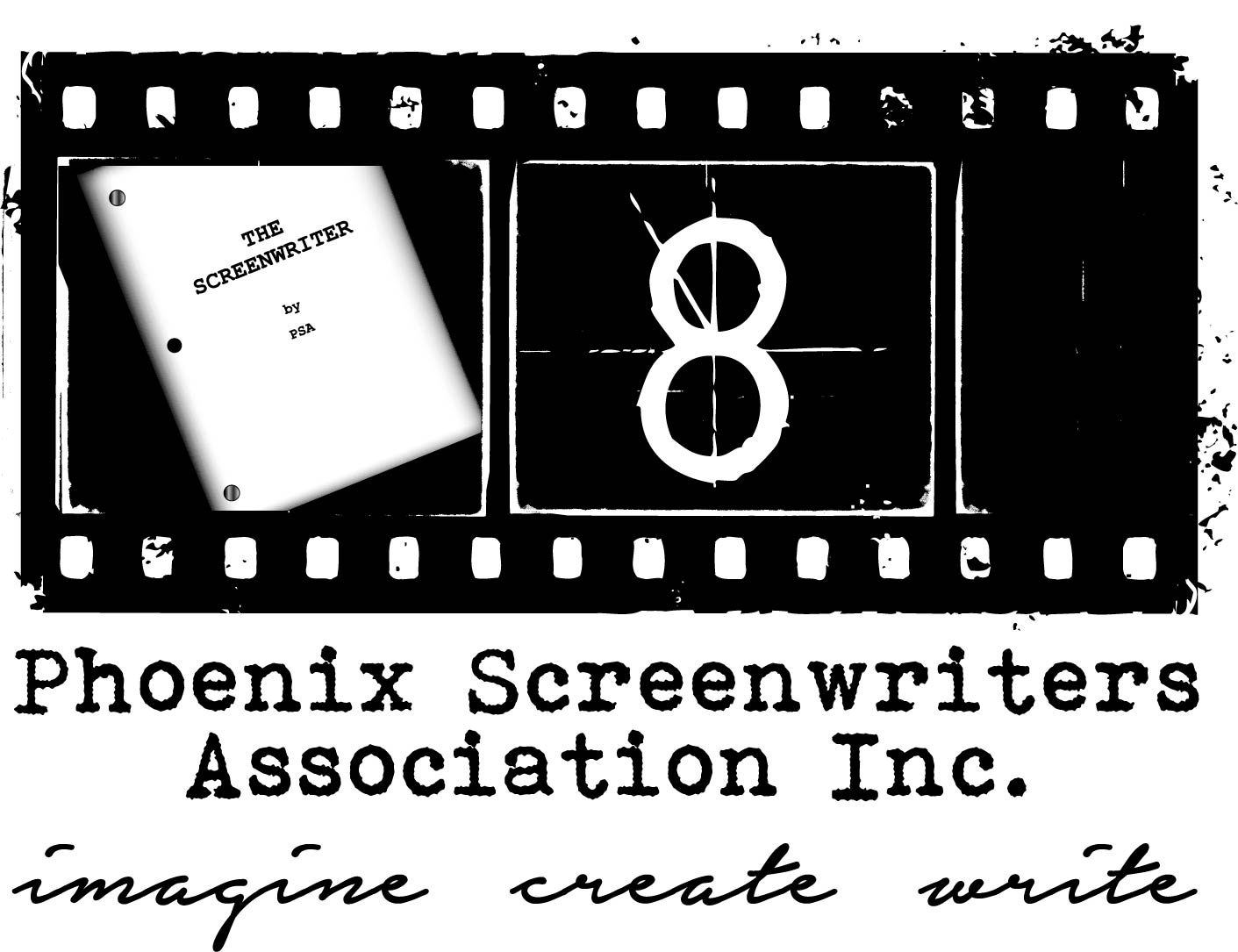Joseph Campbell Character Archetypes
Below is a presentation recreated as a blog post for PSA by Al Titkemeyer a Content Creator for Maricopa County and former Film and Video teacher.
Joseph Campbell is a renowned writer and lecturer, best known for his work in comparative religion and mythology. His research led him to what he termed “the Monomyth.” The concept of the monomyth suggests that humans have been telling the same story over and over again since the beginning of time.
Many screenwriters are taught about Joseph Campbell’s Monomyth and the accompanying image of the hero’s journey may look familiar.

The monomyth is a hero’s journey. The hero has to embark on a journey, and through this quest, they undergo transformation. Upon their return to the ordinary world from the supernatural realm, they bring back new knowledge. This new found wisdom not only transforms the hero but also aids them in transforming their ordinary world.
These are character archetypes that he believes we see in all stories.
The Hero
The hero can take on many different appearances. The hero typically begins in what Campbell refers to as their Ordinary Life. Perhaps our hero is eager for change. We often see teenage heroes. Who is more antsy to explore than adolescents? Think of characters like Dorothy from “The Wizard of Oz” or Luke Skywalker leading his mundane farmboy life.
Maybe our hero is in a transitional moment in life — are they starting high school for the first time, are they on the brink of marriage, or are they simply growing older?
Even more interesting still are the heroes who have the journey forced onto them. They didn’t know it, but the journey calls them.
Whether by choice, timing, or divine intervention, the hero is thrust into an adventure that will transform themselves and their community.
This brings us to our second archetype.
The Herald
The Herald brings about change. The herald is basically the inciting incident, marking the call to adventure. They can be mentors, like Gandalf. A herald might only appear once in a story, like the horror trope of the scary gas station attendant who says, “beware.”
Sometimes the herald brings information our hero is not ready to hear or accept. Sometimes the herald gets to stick around as a mentor or ally. Sometimes the herald isn’t even human. The one thing that makes a herald is that they mark the beginning of the journey. Oftentimes, as Campbell explains in his hero’s journey, there is a moment of doubt after the herald, where our hero questions whether they are the right person for the job.
“Hark, the Herald Angel sings” – Angels are often heralds bringing messages from the other world.
Jacob Marley – A Christmas Carol – In “A Christmas Carol,” Jacob Marley, a ghost, goes to warn Ebenezer Scrooge that he has one chance to change his future and make things right, telling him he will be visited by three ghosts.
The White Rabbit from Alice in Wonderland is often portrayed as a herald with a big horn, announcing that change is coming.
Joseph Campbell states that many myths start with a human’s curiosity that leads them to follow an animal into a new place the hero’s never been before. I think the deer in “Get Out” might be a herald, a herald that later becomes a symbol.
The Mentor
Historically in folktale and religious stories the mentor of the story is a supernatural aid. This character is so important, they’re actually listed as one of the steps of the monomyth in the Hero’s Journey.
The mentor is someone from the extraordinary world who exists to support and challenge our hero. Often the mentor will give the hero something. In many myths the mentor is an old woman or man, in Egyptian mythology they were the boatmen who took the hero to the extraordinary world.
Mr. Miyagi is a clear mentor. He is a Karate master who shows Daniel the ways both physically and spiritually.
Mentors can be complicated. Later on, we will talk about tricksters. Oftentimes, a character can embody multiple archetypes. Not all mentors are good, and many mentors come with their own faults.
Tyler Durden from Fight Club comes from the other world, is supernatural. He brings the narrator into a world he’s never been before. He’s a mentor, but is he a good one?
Is Da Mayor in Do the Right Thing a mentor? What does his character say about the people of Bed-Stuy’s relationship to their roots or to their supernatural aid? He is considered the town drunk, he is the one who tells Mookie “do the right thing.” He saves a child and in the end is the one asking for peace. He’s a complicated mentor in a complicated story where there isn’t a clear answer.
The Ally
Along the journey, our hero will encounter allies, obstacles, and enemies – this is part 6 of the hero’s journey and occurs when the hero embarks on the supernatural realm or starts their descent into the 2nd act.
An ally can be boring and a simple means of giving your character someone to voice their fears and concerns to, OR the ally can challenge your hero, can reflect your hero.
Samwise from Lord of the Rings is an obvious ally – who really brings heart and courage to the story.
Rod from Get Out serves, like many modern ally characters do, not only as support for the hero but also as a humorous break. I think he’s a Trickster Ally.
Friendship Group from Turning Red – Sometimes if your character is lucky they will have a whole band of allies.
Threshold Guardian
The Threshold Guardian is a character or object that is there to ask whether our protagonist wants to change enough to make it through the journey. They aren’t the main antagonist, and sometimes they aren’t even an antagonist, but they serve to stop and question whether our hero wants his goals badly enough or to remind our hero why he wants to succeed and go on the journey.
As the title implies, the Threshold Guardian keeps our hero and challenges our hero before they go into a new threshold – before they enter the belly of the beast. To get past the threshold guardian, our hero must realize something about themselves and change. They must gather the real strength to finish the journey. The Sphinx is a classic example of a threshold guardian; they stand in front of the entrance to a city and ask riddles.
In the hero’s journey our hero has to lose something to be reborn – transfiguration. Sometimes the Threshold Guardian is the one who helps give the hero that death and rebirth.
The furnace in Home Alone. The Furnace is a symbol of kid fears. The furnace in the basement is not the main antagonist but is an obstacle that Kevin needs to face in order to take on the bigger challenges ahead of him.
Inigo Montoya in Princess Bride starts off as a foe to Wesley but is converted to an ally. He might be considered a Shapeshifter Threshold Guardian.
Aunt Meg from Twister is an interesting threshold guardian. She isn’t an antagonist at all, but at a crucial moment where the team must ask themselves, do we keep fighting or do we run away, Aunt Meg is in danger, and this puts all their reasons for storm chasing right in front of them. She becomes a clear symbol of why they are fighting at a critical moment in the movie.
Shapeshifter
This character archetype is a character who changes alliances at some point during the journey.
This character serves to complicate our hero’s journey and asks the audience and our hero – is there a clear right and wrong? Black and White? The character can also serve as a great twist in your film – further building up the stakes.
Stereotypically, this is where the femme fatale character comes into play, think Circe in the Odyssey.
The hitchhiker in Thelma and Louise (beautifully played by a young Brad Pit) can be seen as a kind of male femme fatale in the film. The girlfriend in Get Out fits right in there as a person whose alliances are revealed to be antagonistic.
What about characters whose alliances truly change – Sebastian from Little Mermaid was sent with Ariel on the journey to monitor her and as a spy of sorts but quickly becomes an ally to Ariel.
In Diary of a Wimpy Kid, Rodrick, the brother often interchanges from an antagonist to an ally. Vino from Do the Right Thing is a really interesting character. Is his alliance to his brother, his family, or to his friend Mookie?
Trickster
You can identify a trickster because they live outside of society’s norms and are often misunderstood. They are often comedic relief, sometimes self-interested. The trickster can play tricks that lead to good or bad outcomes. They are often not taken seriously but ultimately are smarter than they let on. Through their otherness, they find success for themselves and the hero.
Again, sometimes these archetypes are combined – sometimes you have a trickster mentor or a trickster hero. The trickster brings a little bit of chaos to the story, disrupting for good and bad the arc of the story.
Chief Bromden in One Flew Over the Cuckoo’s Nest – If you read the book, he is the protagonist, but in the film, he serves more as a trickster mentor. He pretends not to be able to hear or speak. He doubts his own power, even though he’s ridiculously strong, and in the end, he’s the one who helps McMurphy, who ultimately is also a bit of a trickster. Being Native American and misunderstood, he is an outsider. Is anyone surprised that Ken Kesey, a Merry Prankster writes great trickster characters. Ken Kesy himself might be a real trickster.
Phil Dunphy from Modern Family – People make fun of Phil; he is unconventional and definitely not cool, but how often does he save the day?
Buggin’out from Do the Right Thing is an amazing example of a trickster. His fight with Sal over why there aren’t black people on the wall of fame in a black neighborhood seems extreme, but he isn’t wrong either. He gets in a lot of trouble; his energy is more intense about social strife than the others. He’s well-intentioned but misguided in his approach. Or is he?
Hannibal Lecter from Silence of the Lambs is a good example of a trickster mentor. He is in it for personal gain but gives riddles for Clarice to follow.
Rowley Jefferson from Diary of a Wimpy Kid is a Trickster Ally. He is considered uncool by his peers. The main character, Greg, goes on a mission to change his friend, only to find out that Rowley was the one who had it right the whole time..
The shadow
The shadow character is the antagonist but is often a look at the worst characteristics of the protagonist. The hero must face the shadow character in order to better learn about themselves so that they can go into the third act and change their ordinary world.
Shadow characters aren’t the opposite of the main character but often a more extreme foil character to the protagonist.
Patty in Diary of a Wimpy Kid. She’s also obsessed with being the best and most popular, and she’s a control freak just like Greg.
In Fight Club, the main character is his own shadow.
Darth Vader is a great shadow character – this is what Luke could become if he isn’t careful with his need for power.
How can you use these character archetypes to improve your storytelling?
